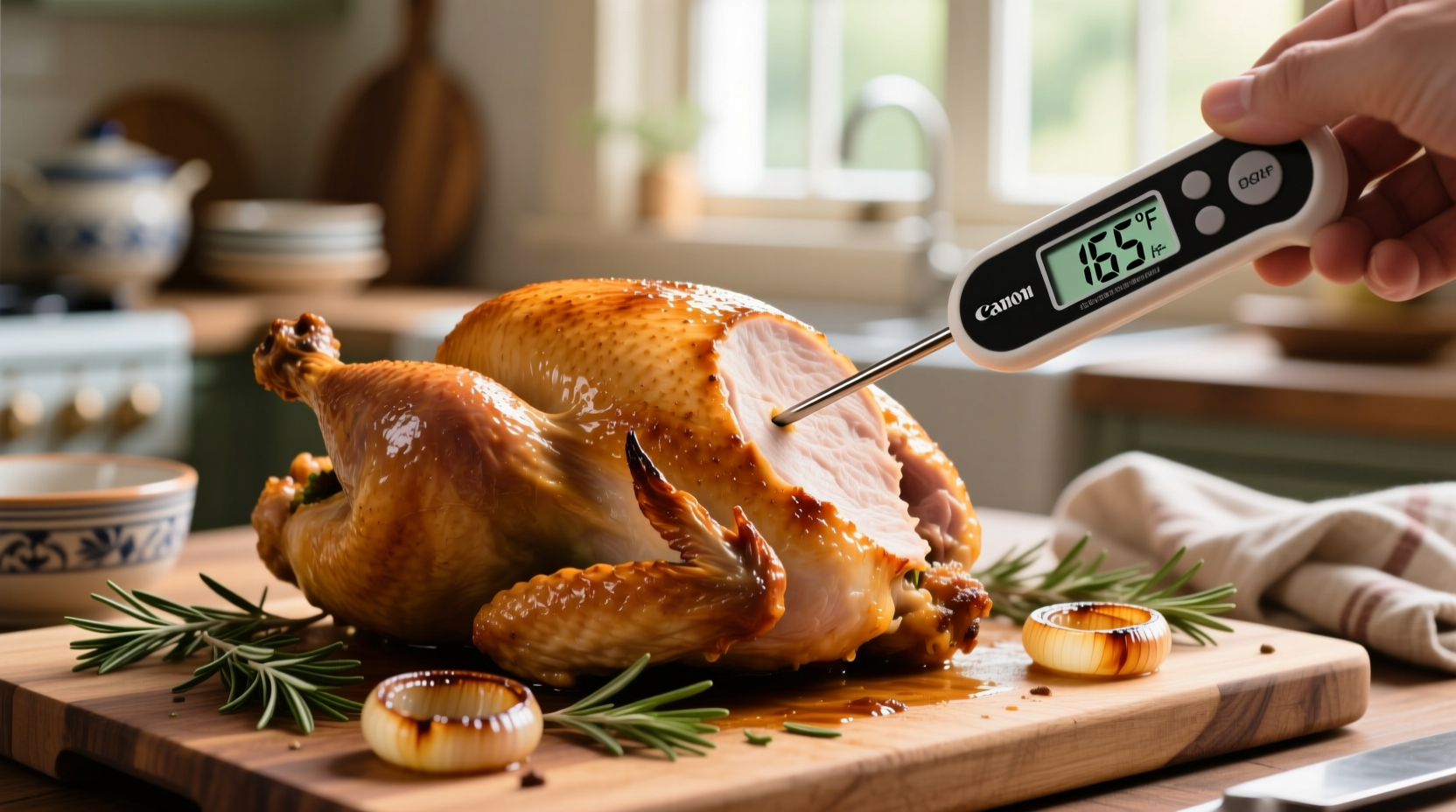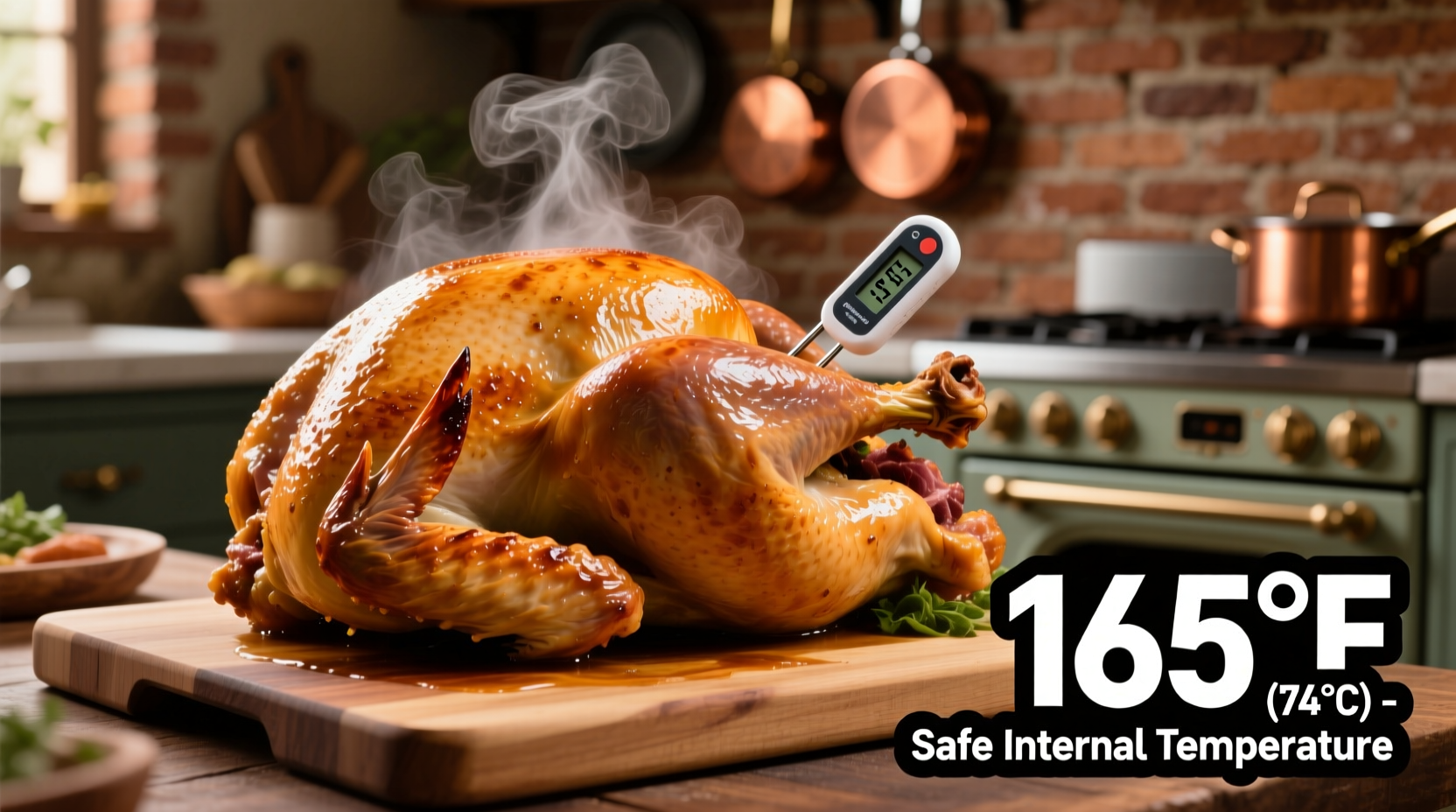Getting your turkey to the proper temperature isn't just about doneness—it's a critical food safety requirement that protects you and your guests from potential illness. While many home cooks rely on visual cues or cooking time estimates, the only reliable method to ensure your turkey is safely cooked is by using a calibrated food thermometer.
Why 165°F Is the Magic Number for Turkey
The 165°F (73.9°C) standard isn't arbitrary—it's based on extensive food safety research. At this temperature, harmful bacteria that commonly contaminate poultry are destroyed almost instantly. According to the USDA Food Safety and Inspection Service, this temperature provides a sufficient safety margin while still delivering moist, flavorful meat.
Many home cooks mistakenly believe turkey must reach 180°F, but this outdated recommendation results in dry, overcooked meat. Modern food safety science confirms that 165°F is both safe and produces better results.

Where and How to Check Your Turkey's Temperature
Proper temperature measurement technique is just as important as the target temperature itself. Here's how to do it correctly:
- Use the right thermometer: Digital instant-read thermometers provide the most accurate results for turkey
- Check multiple spots: Measure in the innermost part of the thigh, wing, and thickest part of the breast
- Avoid bone contact: Place the probe in meaty areas, not touching bone which conducts heat differently
- Check early and often: Begin checking temperature about 45-60 minutes before expected doneness
Temperature Requirements Across Authoritative Sources
| Organization | Recommended Temperature | Notes |
|---|---|---|
| USDA Food Safety and Inspection Service | 165°F (73.9°C) | Minimum safe temperature for all poultry |
| Food and Drug Administration | 165°F (73.9°C) | Specified in FDA Food Code |
| Food Safety Authority of Ireland | 75°C (167°F) | Must reach this temperature within 30 seconds |
| Canadian Food Inspection Agency | 74°C (165°F) | Verified with food thermometer |
Understanding Temperature Evolution in Poultry Safety Guidelines
Food safety recommendations for poultry have evolved significantly over time as our understanding of foodborne pathogens has improved:
- 1940s-1970s: Recommendations focused primarily on cooking until "no longer pink" with no specific temperature guidelines
- 1980s: USDA recommended 180°F for whole turkey based on older research
- 1990s: Research showed 160°F was sufficient but safety margin was considered too narrow
- 2006: USDA officially updated recommendation to 165°F after extensive pathogen testing
- Present: 165°F remains the standard, with emphasis on proper thermometer use
Carryover Cooking: The Secret to Perfectly Juicy Turkey
One crucial factor many home cooks miss is carryover cooking—the continued cooking that happens after turkey is removed from heat. Turkey's large mass retains significant heat, causing the internal temperature to rise 5-10°F during resting.
Here's how to use carryover cooking to your advantage:
- Remove turkey from oven when thermometer reads 160-162°F
- Cover loosely with foil and let rest for 20-30 minutes
- Temperature will continue rising to the safe 165°F mark
- Resting also allows juices to redistribute for moister meat
Special Considerations for Different Turkey Preparations
While 165°F remains the universal safety standard, different cooking methods require slight adjustments to your approach:
- Deep-fried turkey: Requires careful monitoring as exterior can brown before interior reaches safe temperature
- Spatchcocked turkey: Cooks faster; check temperature 30-45 minutes earlier than whole bird
- Smoked turkey: Low-and-slow cooking requires patience; temperature rise will be gradual
- Grilled turkey: Direct heat can create hot spots; check multiple areas frequently
Common Temperature Mistakes and How to Avoid Them
Even experienced cooks make these temperature-related errors:
- Mistake: Relying on pop-up timers
- Reality: These often trigger at 165-180°F but can activate too early; always verify with thermometer
- Mistake: Checking temperature too infrequently
- Reality: Check every 15-20 minutes during final cooking phase to prevent overcooking
- Mistake: Not calibrating your thermometer
- Reality: Test in ice water (32°F) or boiling water (212°F) before use
What Happens If Your Turkey Doesn't Reach 165°F?
Consuming undercooked turkey poses real health risks. According to the Centers for Disease Control and Prevention, Salmonella bacteria—commonly found in raw poultry—can cause severe foodborne illness with symptoms including diarrhea, fever, and abdominal cramps.
If your turkey hasn't reached 165°F:
- Return it to the oven immediately, even if carving has begun
- Continue cooking until proper temperature is reached
- Do not serve undercooked turkey, even if it appears done
Temperature Troubleshooting Guide
Encountering issues with your turkey's temperature? Here's how to handle common problems:
- Problem: Breast reaches 165°F before thighs
- Solution: Cover breast with foil and continue cooking until thighs reach temperature
- Problem: Temperature stalls during smoking
- Solution: This is normal during the "plateau" phase; be patient and continue cooking
- Problem: Temperature rises too quickly
- Solution: Reduce oven temperature by 25°F and monitor closely
Final Temperature Verification Before Serving
Before carving your turkey, perform one final temperature check:
- Insert thermometer into thickest part of breast (avoiding bone)
- Check innermost part of thigh (again avoiding bone)
- Verify both areas have reached at least 165°F
- If using stuffing, check its temperature separately (must also reach 165°F)
Remember that food safety should always take precedence over texture or appearance concerns. A properly cooked turkey that's slightly less moist is far better than an undercooked bird that could make your guests ill.











 浙公网安备
33010002000092号
浙公网安备
33010002000092号 浙B2-20120091-4
浙B2-20120091-4